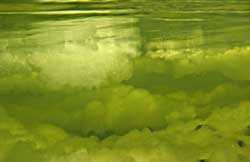Extreme winters impact fish negatively

It is difficult to be a fish when the bottom of the river is covered with ice. Winter image from the river Orkla in Norway. Photo: Knut Alfredsen<br>
It is well known that winter can be a stressful season for plants and animals in streams and rivers. It is reasonable to assume that it is the more extreme weather conditions that are the most taxing, but the ecological significance of this is poorly understood.
The research team, headed by Professor Christer Nilsson at Umeå University, describes how extreme conditions – especially those associated with ice formation and ice break-up – vary over time and affect both the non-living environment and its fish. For example, waterways can fill up with ice and kill all fish that do not manage to flee to backwaters or deeper stretches of quiet water that is not filled with ice. Young fish are especially vulnerable.
The researchers also discuss how humans have impacted what happens in streams and rivers in the winter.
“Rivers that have been exploited for hydroelectric power can be especially hard for fish to live in, because the way hydropower is produced often means that the flow is radically changed again and again, which can lead to repeated ice break-ups and a great deal of bottom ice formation. When the ice cover at the surface disappears, cold air is fed downward in the water and forms ice crystals that cover the bottom, making it hard for fish to survive,” says Christer Nilsson.
The scientists draw a number of conclusions from the study. One is that more measurements are needed in order to be able to predict when extreme situations in waterways may arise and that information about both the lives of different fishes and how they are affected by extreme events should be included in such data gathering. Another is that models of how water moves and what fish populations look like should also take winter conditions into consideration.
Today most models are about the ice-free period. A third conclusion is that in order to be able to manage streams and rivers in a long-term sustainable manner, we need to pay attention to future changes in climate, for example, when we design restoration and conservation measures.
“The predictions made about what the winter climate will be like in the future say that there will be more back and forth between thaw and frost, entailing more unstable ice conditions, more rain, and flooding, and ultimately perhaps more challenges to the survival of fish in many waterways,” says Christer Nilsson.
Original publication:
The article will be published in the March issue of BioScience
Weber, C., C. Nilsson, L. Lind, K.T. Alfredsen & L.E. Polvi. 2013. Winter disturbances and riverine fish in temperate and cold regions. BioScience 63:199-210. doi:10:1525/bio.2013.63.3.8.
For more information, please contact:
Christer Nilsson, Department of Ecology and Environmental Science, Umeå University, Phone: +46 (0)90-786 60 03, E-mail: christer.nilsson@emg.umu.se
Media Contact
More Information:
http://www.umu.seAll latest news from the category: Ecology, The Environment and Conservation
This complex theme deals primarily with interactions between organisms and the environmental factors that impact them, but to a greater extent between individual inanimate environmental factors.
innovations-report offers informative reports and articles on topics such as climate protection, landscape conservation, ecological systems, wildlife and nature parks and ecosystem efficiency and balance.
Newest articles

Bringing bio-inspired robots to life
Nebraska researcher Eric Markvicka gets NSF CAREER Award to pursue manufacture of novel materials for soft robotics and stretchable electronics. Engineers are increasingly eager to develop robots that mimic the…

Bella moths use poison to attract mates
Scientists are closer to finding out how. Pyrrolizidine alkaloids are as bitter and toxic as they are hard to pronounce. They’re produced by several different types of plants and are…

AI tool creates ‘synthetic’ images of cells
…for enhanced microscopy analysis. Observing individual cells through microscopes can reveal a range of important cell biological phenomena that frequently play a role in human diseases, but the process of…





















